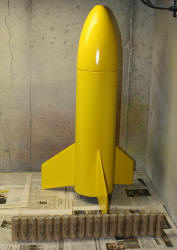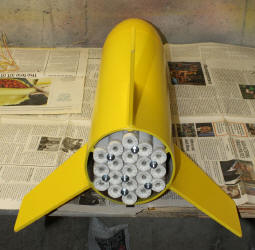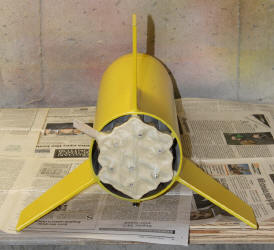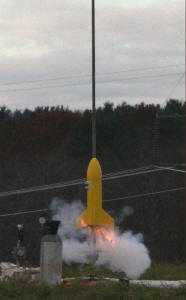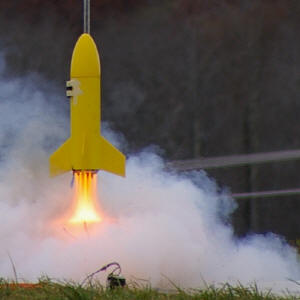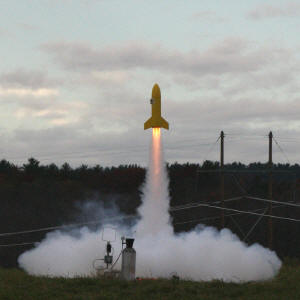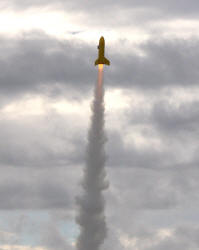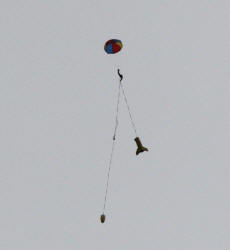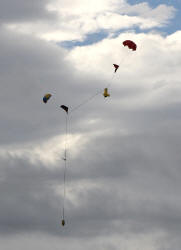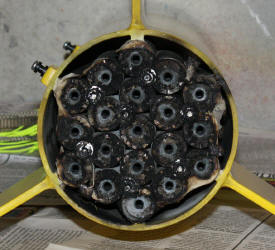| please see links above for
later flights flight 2: 11/21/10 CMASS Amesbury,
MA
1x Pro-X F30 White (AP)
+ 18x D11-P (BP) motors
Impulse: 1x 73 Ns + 18x 18 Ns = 397 Ns total
Thrust: 1x 30 N + 18x 11 N = 228 N
19 motors = I-228 |
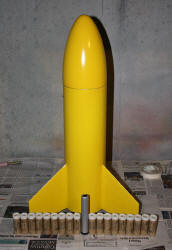
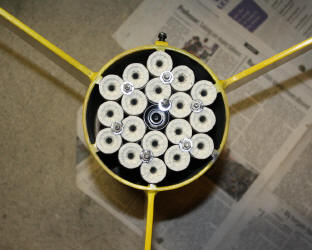 |
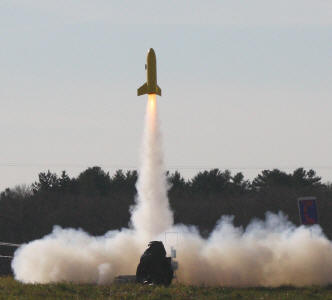
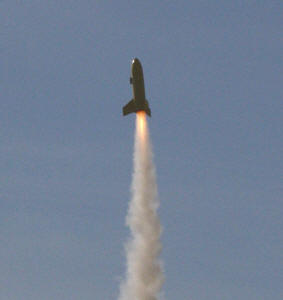
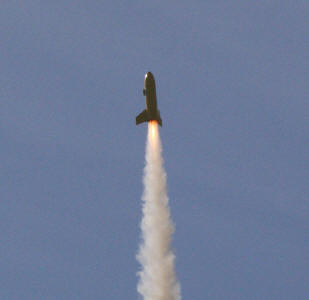
The flight went very well, firing all 19 motors and reaching 863 ft.
BP motors were fired by a QM flashpan. Used
one Rocketflite ML igniter for the AP motor and another for the flashpan.
Flashpan was also exposed to AP motor exhaust to have two ignition sources.
Used a small cotton string beneath 3 BP motors to prevent rocket creeping up
the rail before the BP motors were pushing hard.
In the first flight the rocket took 0.5 seconds from first visible sign of
ignition until it started moving up the rail. In this flight the time was
reduced to 0.4 seconds, likely due to the addition of the fast hitting ProX
motor.
Times were determined by counting video frames in 720 60p video.
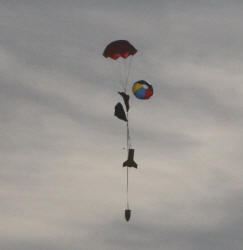
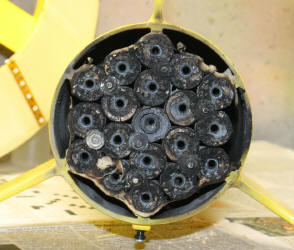 |
Slight wiggle during boost suggested the need
for slightly more nose weight with this engine combination. Flight was
in very low winds.
Main chute was slow to unfurl, so I'll pack it to deploy more quickly
next time. That's me trying to talk the chute into opening up in the
video.
Once again, the rocket is in great shape and will fly again next spring.
Maybe with the addition of some cool flame graphics... |
|
|
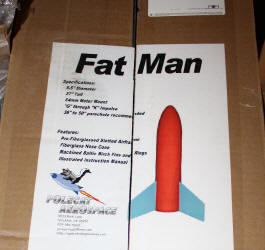
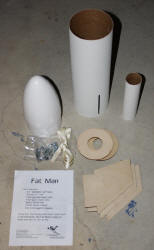 |
The Polecat Aerospace 5.5" Fat
Man kit comes with a fiberglass nose cone, pre-glassed body tube (looks like
LOC 5.5"), beveled 1/4" fins, 2 centering rings, 54mm engine tube, plus some
other hardware and instructions. Flier supplies chute. A good deal at $99.
As a 2x upscale of the classic Estes Fat Boy, it has a wide body ideal for
clusters.
Plan is to use low cost 24mm motors, 19x of these fit well in a 5.5"
airframe. |
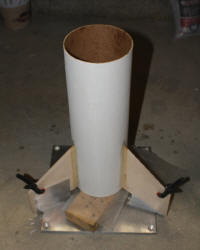
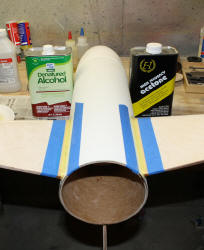
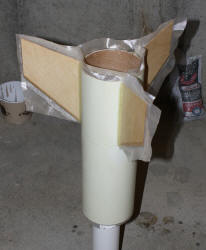
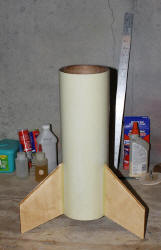
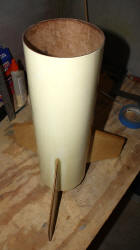
Used a jig from BMI to align fins. For this
mod glued a 6" coupler tube at the bottom of the body tube. Trimmed the tabs
on the TTW fins. Then epoxied them into the slots in the body tube, butting
them up against the coupler tube.
Generous fillets with thick, fast Locktite 5 minute epoxy. Then glassed very
lightly using thin 1.3oz FG layers. Three layers where fins join body, one
layer everywhere else. West 206 epoxy. Just enough to help anchor the fins
and provide a hard, smooth surface to the exterior.
After plenty of sanding, applied a topcoat of epoxy and then sanded that
down.
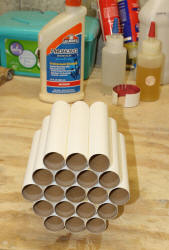
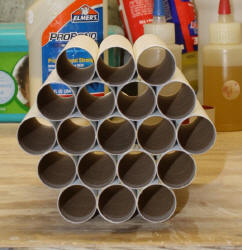
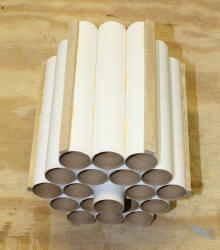
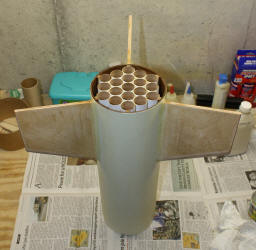
|
Cut LOC 24mm tubing into
18 pieces 5.5" long and one 6" long for the center. The center tube
contacts the solid bulkhead, other tubes are shorter to avoid
interference with bottom parts of recovery hardware. Glued tubes into a
honeycomb using yellow, quick-tacking Elmers.
Cut strips from a "stiffy" tube at 6 contact points, these plus the top
of the center motor tube hold the motor honeycomb into the rocket.
Painted West 206 epoxy on the outside of the motor honeycomb and inside
of the space they mount into, to bond and fire-harden.
Rocket body (no NC) went from 2.0lbs to 2.5lbs with addition of motor
tubes. |
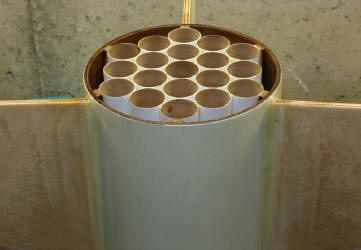 |
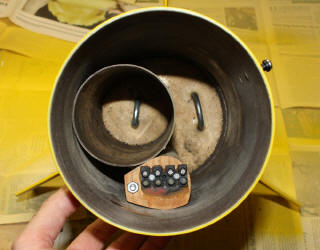
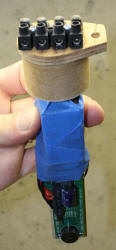
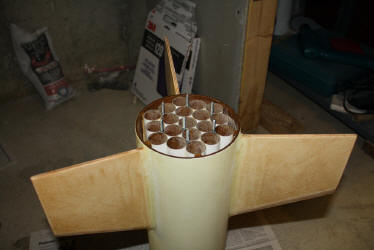
Painted inside of the recovery area with
thinned epoxy for fire resistance (West 206 + 25% alcohol by weight). 38mm
internal tube for altimeter and 3" internal tube for main chute.
The altimeter sled with PerfectFlite HA45K altimeter, Duracell 9V battery
and Featherweight screw switch (other side). There is a wooden block below
the battery, the tape only has to retain its sidewards motion inside a tight
fitting tube. Deployment ground tests confirm 1.5g BP for main and 1.5g for
drogue.
Added 7x threaded rods for retention, 3" long 8-32, with 3/4" exposed. Also
painted the inside of the motor tubes with thinned epoxy for physical and
fire hardening.
Rocket is 6.1 lbs flight ready minus motors, will be 7.9 lbs with 19x
D11-Ps. A BP "I" impulse flight.
Will likely reach 700-800 ft, so dual deploy is not really necessary but I
like having a second recovery event and chute for insurance. Also
facilitates higher impulse options in the future.
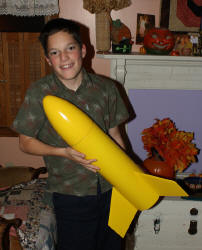
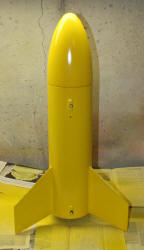
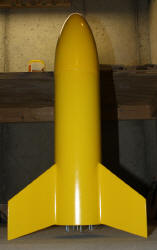
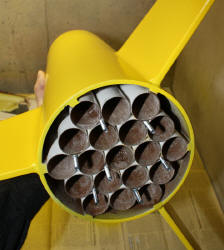
Paul holding the Hell Boy. Mounted rail buttons on 1/4"
thick basswood risers, both to prevent rail from scraping rocket and to give
the rail button screws more to bite into. Rail buttons are just loose enough
to rotate freely, for reduced friction and better longevity.
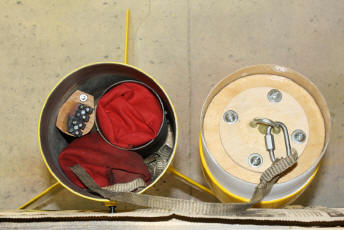
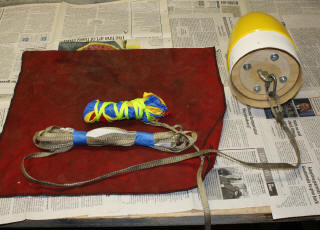
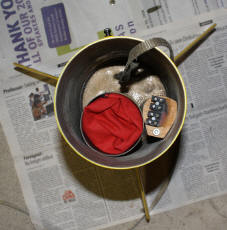
For main wrapped a 45" chute and short Kevlar harness in an 18" square Nomex
sheet and packed that into the internal 3" tube. For flight will put one
long strip of masking tape over this after the ejection charge is inserted.
Top Flight Recovery parts.
Drogue is 24" CATO chute on Kevlar harness. Shortened harness and added
nylon section after first flight. |








